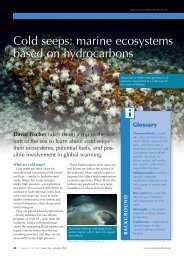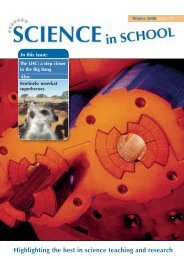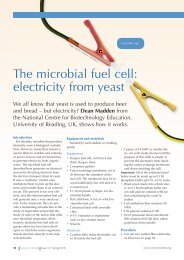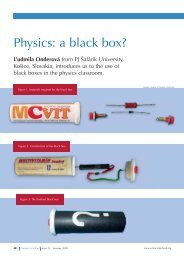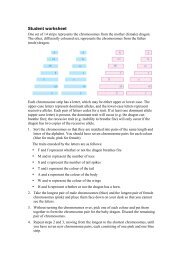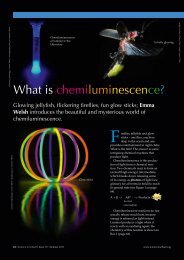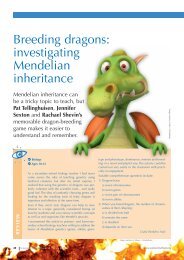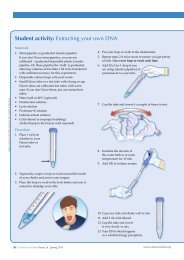Download Issue 14 as PDF [5.4 MB] - Science in School
Download Issue 14 as PDF [5.4 MB] - Science in School
Download Issue 14 as PDF [5.4 MB] - Science in School
You also want an ePaper? Increase the reach of your titles
YUMPU automatically turns print PDFs into web optimized ePapers that Google loves.
Image courtesy of Irena Štrumbelj Drusany<br />
Fl<strong>as</strong>k A B C d E<br />
Volume of stock<br />
glucose solution (ml) 2 3 6 8 10<br />
Volume of distilled<br />
water (ml) 98 97 94 92 90<br />
Glucose concentration<br />
(mg/ml) 0.3 0.45 0.9 1.2 1.5<br />
Table 1: Prepar<strong>in</strong>g the standard glucose solutions<br />
2. Label and fill six test tubes <strong>as</strong> specified <strong>in</strong> Table 2.<br />
Sample number Blank 1 2 3 4 5<br />
Standard glucose<br />
solution (fl<strong>as</strong>k) N/A A B C D E<br />
Volume of standard<br />
glucose solution (ml) 0 1 1 1 1 1<br />
Volume of DNSA<br />
reagent (ml) 1 1 1 1 1 1<br />
Volume of distilled<br />
water (ml) 3 2 2 2 2 2<br />
Table 2: Prepar<strong>in</strong>g the solutions for the calibration curve<br />
3. Heat the test tubes and their contents <strong>in</strong> boil<strong>in</strong>g water for 5<br />
m<strong>in</strong>; the DNSA reagent will react with any sugar present,<br />
produc<strong>in</strong>g a red-brown product.<br />
4. Cool the test tubes, add 6 ml distilled water to each and<br />
shake well.<br />
5. Us<strong>in</strong>g the blue LED (430 mm) of the spectrometer, me<strong>as</strong>ure<br />
the transmittance of each solution.<br />
The read<strong>in</strong>gs from the Spektra <strong>in</strong>strument are transmittances<br />
expressed <strong>in</strong> percentages and should be divided by 100 to<br />
obta<strong>in</strong> the transmittance values used <strong>in</strong> the subsequent calculations.<br />
Transmittance is related to absorbance <strong>as</strong> described by the<br />
equation: A = –log T. See the second and third columns <strong>in</strong> Table 3.<br />
The image below shows the calibration solutions; even the<br />
blank (water and DNSA with no glucose) is an <strong>in</strong>tense colour. It<br />
is therefore necessary to me<strong>as</strong>ure all the samples, <strong>in</strong>clud<strong>in</strong>g the<br />
blank, aga<strong>in</strong>st distilled water. The glucose-specific absor bance<br />
of the samples is then calculated by subtract<strong>in</strong>g the absorbance<br />
me<strong>as</strong>urement of the blank from the absorbance me<strong>as</strong>urement of<br />
the sample (see the fourth column of Table 3).<br />
Figure 4: The<br />
calibration<br />
solutions<br />
6. Plot glucose concentration aga<strong>in</strong>st glucose-specific<br />
absorbance, <strong>as</strong> shown <strong>in</strong> Figure 5.<br />
Glucose Transmittance Absorbance Glucose-specific<br />
concentration (Spektra read<strong>in</strong>g, (A) absorbance<br />
(mg/ml) T%) (A – A blank )<br />
Glucose-specific absorbance (A-A blank )<br />
0.3<br />
0.2<br />
0.1<br />
0 (Blank) 27.54 0.56 0<br />
0.3 23.44 0.63 0.07<br />
0.45 20.04 0.69 0.13<br />
0.9 18.21 0.74 0.18<br />
1.2 15.13 0.82 0.26<br />
1.5 <strong>14</strong>.45 0.84 0.28<br />
Table 3: Calibration curve – sample absorbance me<strong>as</strong>urements of<br />
different concentrations of glucose solution<br />
0<br />
Glucose concentration<br />
0.25 0.5 0.75 1.0 1.25 1.5 2.0<br />
Figure 5: Sample calibration curve – glucose-specific absorbance<br />
aga<strong>in</strong>st concentration of glucose<br />
Me<strong>as</strong>ur<strong>in</strong>g the jam samples<br />
The jam samples should be treated similarly to the glucose<br />
solutions used for the calibration curve.<br />
1. For each jam to be tested, put 1 ml prepared jam sample<br />
(see ‘Preparation of solutions’) <strong>in</strong> a test tube and add 1 ml<br />
DNSA reagent and 2 ml distilled water.<br />
2. Heat the test tubes and their contents <strong>in</strong> boil<strong>in</strong>g water for<br />
5 m<strong>in</strong>; the DNSA reagent will react with any sugar present,<br />
produc<strong>in</strong>g a red-brown product.<br />
3. Cool the test tubes, add 6 ml distilled water to each and<br />
shake well.<br />
4. Us<strong>in</strong>g the blue LED (430 nm) of the spectrometer, me<strong>as</strong>ure<br />
the transmittance value (T%) of each jam sample. Divide by<br />
100 to obta<strong>in</strong> T, convert T to A us<strong>in</strong>g the equation A = –log T,<br />
and use that to calculate the glucose-specific absorbance<br />
(A – A blank ).<br />
Table 4 shows an example of the transmittance values obta<strong>in</strong>ed<br />
and the calculated glucose-specific absorbance of each sample.<br />
46 <strong>Science</strong> <strong>in</strong> <strong>School</strong> <strong>Issue</strong> <strong>14</strong> : Spr<strong>in</strong>g 2010<br />
www.science<strong>in</strong>school.org


![Download Issue 14 as PDF [5.4 MB] - Science in School](https://img.yumpu.com/26126440/48/500x640/download-issue-14-as-pdf-54-mb-science-in-school.jpg)


